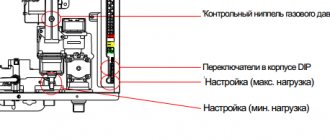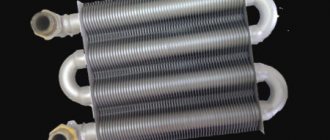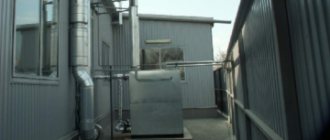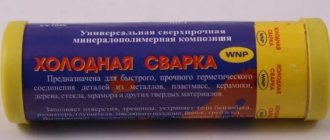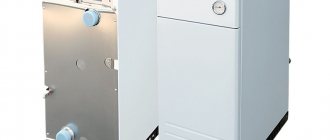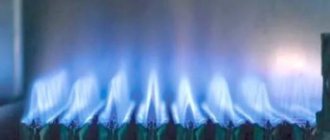A boiler is a heat-generating device that is, as a rule, responsible for the autonomous and uninterrupted operation of engineering networks of those buildings that are not connected to city and public communication networks for one reason or another. Boiler equipment is the number one solution among owners of private cottages, country houses and dachas with different modes of residence - permanent or temporary.
Private boiler houses can operate on different types of fuel: gas, wood or coal, diesel. But they always come in two types: single-circuit and double-circuit. In this article we will talk about gas devices in one circuit: the main parameters and characteristics, design and equipment, operating principle and other features of this type of units will be considered.
What is "one circuit"?
One boiler circuit means that the device generates heat using a coolant - its heating, preparation and supply to the heating system of the facility.
Hot coolant is supplied only to batteries and radiators; single-circuit models do not provide other full-fledged functionality. Some models provide the possibility of additional configuration and connection to the device of an indirect heating boiler. Full heating of water not only for heating purposes, but also for the operation of hot water supply systems and “warm floors” is fully ensured by dual-circuit models. And why then buy a single-circuit boiler? – a natural question may arise. And then, that these devices provide their own advantages, which are suitable for specific purposes and satisfy the individual needs of users.
Thus, global experience in using single-circuit and two-circuit models allows us to make the following comparative characteristics of boilers with one and two circuits:
- double-circuit installations often demonstrate a low level of performance for hot water supply: sometimes ensuring the operation of the DHW system is possible only at a very low level. High needs for hot water for a large family will require not only the choice of a double-circuit model, but also the choice of a complex wiring diagram for utility networks and the installation of additional equipment, for example, pumps, larger-volume boilers, and so on;
- the level of water supply from dual-circuit devices may be unstable: fluctuations and changes in water temperature may be observed while taking a shower in cases where other plumbing taps in the hot water system are turned on in parallel;
- The vast majority of single-circuit boiler models can be equipped with a boiler or other types of water heaters: single-circuit models allow you to comfortably use additional equipment without interruptions in the supply of hot water.
Advice from experts.
When choosing the number of circuits and the level of equipment equipment, it is recommended to primarily base it on your personal needs for hot water consumption. Because the heating parameters of both types of installations will be equally good - after all, they are designed specifically for heat generation purposes. But if there are high requirements for hot water consumption, for example, for a large family, it is better to choose a single-circuit boiler with additional equipment with a boiler to avoid supply interruptions.
Single-pipe system "Leningradka"
"Leningradka" is recognized as the most reliable heating system. Also refers to the natural type of circulation. Considering the ease of assembly, the price/quality ratio, and the efficiency of heating the room, this is the best wiring option at the moment. This scheme is a system of series-connected heating batteries with one pipe. The coolant is heated using a boiler. This option is ideal for small cottages using a pump to circulate the liquid.
The most common type of single-circuit models
The vast majority of gas boilers, regardless of the number of circuits, are wall-mounted - that is, they are designed for installation on a wall, which must be load-bearing and durable. The wall-mounted installation method implies small dimensions and weight of the boiler, which acts as an additional advantage for users when choosing, since they take up little space and do not require the organization of a special room for the boiler room.
Such installations can be used both in suburban and urban environments. For example, this type of boiler device is often installed today in new urban residential complexes to provide an autonomous heating and hot water system.
Prices: summary table
Comparative rating of wall-mounted single-circuit gas boilers:
| Boiler name | Efficiency, % | power, kWt | Gas consumption, m3/h | price, rub. |
| BAXI ECO Four 1.24 | 91,2 | 24 | 2,7–2,0 | 37 000 |
| Protherm Panther 25 KTO | 92,8 | 25 | 2,8–2,1 | 57 000 |
| Vaillant TEC VU 242 5-5 | 91,9 | 24 | 2,9–2,2 | 75 500 |
| Viessmann Vitopend 100 W | 93,0 | 30 | 3,4–2,5 | 56 000 |
| Buderus Logamax U072-18 | 92,1 | 18 | 2,0–2,8 | 40 000 |
| Rinnai BR-UE30 | 92,8 | 29 | 2,7–2,5 | 61 500 |
Construction and equipment of boilers with one circuit
The fundamental design of gas units has not changed for many decades, largely because it is quite simple and very effective. All gas boilers are of the same type and are designed in the same way, namely, they consist of:
- The combustion chamber in which the gas combustion process takes place, during which the fuel is transformed into heat;
- Burners. Usually has the shape of a rectangle, is responsible for igniting the gas and uniformly burning the flame and spreading it throughout the entire volume of the combustion chamber;
- Heat exchanger. Responsible for the process of transferring heat generated by the combustion of the flame to the coolant, which further transfers thermal energy to the functional elements of the heating system;
- Smoke channel. In other words, a chimney through which the products formed by the gas combustion process and smoke are discharged outside into the atmosphere.
- A branch pipe for organizing the connection to a single-circuit boiler of an external, separate water heater - boiler. Today, the vast majority of single-circuit boiler models are equipped with such pipes.
Methods for increasing the thermal inertia of a system
If the winters in your region are cold and you are concerned that the batteries will cool down when using DHW, we will give you a couple of tips on how to avoid this. Of course, first of all you need to take care of good thermal insulation of walls and windows, roof and floor, but that’s not what the appeal is about.
The only method to stop the cooling of the coolant is to increase its heat capacity. This can be achieved by increasing the volume of coolant through the use of larger diameter pipes.
In addition, it is possible to use massive cast iron batteries with floor installation. Such heating devices take a very long time to cool down, since their mass can be about 100 kg.
Finally, as already mentioned, it is possible to integrate a heat accumulator into the system - a tank of a couple of hundred liters (up to 2000), connected between the heating system and the boiler. But this will negate all the advantages of the scheme: it will become more expensive and will take up extra space.
The principle of operation of a single-circuit gas boiler
The operation of a gas unit with one heating circuit is simple, making such equipment convenient to operate and, if necessary, easy to repair.
The equipment operation scheme is carried out in the following stages:
- Fuel (gas) is supplied to the boiler burner and ignited by a special igniter or piezoelectric element. The gas-air mixture automatically ignites.
- When burned, the gas forms combustion products of high temperatures - they wash the heat exchanger and, using convection, transfer their thermal energy to the coolant, which, through the supply pipe, enters the heat exchanger cooled from the heating system.
- The coolant heated by the heat exchanger moves through the outgoing pipe back to the elements of the heating system - radiators and batteries. The circulation of heated water can occur naturally or using a special pump.
- Getting into the radiators and radiators, hot water transfers thermal energy to the air in the room using convection.
- A new cycle of movement begins - having given up heat to the batteries, the coolant rushes back to the boiler.
As can be seen from the diagram described above, the design of single-circuit gas boilers is quite simple and is based on the circulation of coolant from the boiler to the batteries and back. All this time, the boiler burner works without stopping and the flame from the gas heats the heat exchanger. The hot smoke gradually cools down and is finally discharged cold through the chimney to the street.
Scheme of a single-circuit heating system
The operating diagram of this system is very simple:
- The coolant is heated by the boiler and enters the distribution system
- The heated liquid flows through the pipe to the first radiator
- Then, having passed through the first radiator, the coolant enters the next ones in turn.
- After passing the outer radiator, the liquid enters the boiler. The cycle repeats.
Diagram of a single-circuit heating system
This operating scheme operates on a forced or gravitational principle. In the first case, the pressure in the system is provided by a circulation pump. It is installed between the outer radiator and the boiler. The pump builds up pressure in the pipes, so no additional slopes or cuts are needed. Systems with bottom wiring are assembled using this principle. The pipe stretches almost to the floor along the entire perimeter of the heated premises. This system is very easy to assemble. In addition, the interior does not suffer from the presence of this system.
Types of boiler units with one circuit
Despite the simplicity of the design and operation of boiler units in one circuit, the types of their modifications, configurations and equipment are presented in great abundance on the market. So, this equipment can be classified according to the following characteristics:
- Installation method: floor and wall models;
- Method of operation: volatile (requiring connection to the electrical network) and non-volatile (autonomous, not requiring power supply);
- The method used for heat transfer: condensation (for low flue gas temperatures), convection (classic type) and parapet models;
- Method of arranging the combustion chamber and burner: atmospheric burners, open burners and turbocharged ones (when the combustion chamber is closed);
- A type of heat exchanger material that can be made of steel, cast iron or copper. Wall-mounted boilers are usually equipped with heat exchangers made of light materials - stainless or enameled steel, copper. Floor-standing models, as a rule, have more reliable heat exchangers made of cast iron.
The best known manufacturers and models: characteristics and prices
BAXI ECO Four 1.24
The famous Italian boiler with an open combustion chamber from the popular BAXI ECO line stands out for its particular reliability and durability (even among other European models) at an extremely affordable price.
Its hydraulic unit is equipped with a pressure gauge, an automatic bypass and a coolant filter, and the integrated control unit has options for weather-dependent regulation and self-diagnosis. With a power of 24 kW, it consumes 2.7 m3/h (LPG 2.0 kg/h). The primary heat exchanger is made of copper.
Protherm Panther 25 KTO
This model belongs to the middle class equipment (increased comfort) - it is convenient both in connection and in everyday use.
A turbocharged unit has a closed combustion chamber. The heat exchanger, internal wiring and inlet-outlet pipes are made of copper. A burner with a modulation depth of up to 25 kW burns 2.8 m3/h (LPG 2.1 kg/h) of gas at maximum power.
Vaillant turbo TEC plus VU 242 5-5
This German reference gas boiler with a power of 24 kW has long been recognized by craftsmen as the leader among all turbocharged units in terms of reliability and build quality.
German models are always distinguished by extreme reliability and resistance to any operating conditions, which is ensured by the use of modern alloys and technologies. It has an alphanumeric display with an expanded list of information codes, a circulation pump with auto-switching, a copper heat exchanger and a burner made of chromium-nickel steel that is not subject to burnout. Maximum fuel consumption 2.9 m3/h (LPG 2.2 kg/h).
The only drawback is vulnerability to voltage surges (it is advisable to connect to the network through a stabilizer).
The best German gas boilers The most efficient, reliable and functional models on the market
Viessmann Vitopend 100-W A1HB002
Another reference German representative, the low-temperature unit is one of the best gas wall-mounted single-circuit boilers for heating a private home, especially popular in the EU.
It contains a copper heat exchanger and a “smart” controller with a self-tuning function, which protects the automation system from fluctuations in the gas and electrical networks. This allows him to adapt to the most extreme situations. For a power of 30 kW it is quite economical - 3.4 m3/h (LPG 2.5 kg/h).
According to operating practice and owner reviews, all models have been operating without problems for more than 6 years.
Buderus Logamax U072-18
An inexpensive unit with a power of 18 kW with a copper heat exchanger was created specifically for operation in typical Russian conditions, including freezing temperatures.
Its advantage is its low price, excellent design and efficiency. The service structure of Buderus is extremely developed in Russia and is known for the presence of competent specialists in almost all regions. Maximum fuel consumption is 2.0 m3/h (LPG 2.8 kg/h).
Rinnai BR-UE30
The well-known Japanese model, despite its ultra-compact size, has a rather impressive power of 29 kW. It also has a copper heat exchanger installed.
Like all Asian boilers, it pays special attention to the comfort of the owner, so it includes a set of side modules: voice navigator, remote access (remote control, Wi-Fi) and weather-dependent automation. Precise temperature regulation helps him minimize gas consumption - 2.8 m3/h (LPG 2.5 kg/h).
Wall-mounted or floor-standing unit?
Single-circuit models are divided into two types:
- floor
- wall-mounted
Wall-mounted options are always compact, small in size and extremely convenient in location. Due to their small dimensions, they are easy to install on the wall - the main thing is that it is strong and load-bearing. And since such a boiler is located on the wall, it significantly saves useful living space. Moreover, it does not require the installation of a foundation or any additional devices, which are often required for the second type - floor-standing units. The power spectrum of wall-mounted options usually reaches a maximum of 35 kilowatts, which is optimal for heating houses and other spaces with a total area of about 300 square meters.
Floor-standing options are always large in size and take up a lot of space. It is strongly recommended to allocate a special room for such units - a mini boiler room. This could be a basement, or a utility room, such as a cellar, closet or pantry. The difficulty in this matter is the piping - when choosing a separate room, you should take into account the possibility of connecting all the required elements of the heating system to it.
At the same time, due to their large weight, such boilers require either the preparation of a special foundation that would take the weight of the apparatus, or a very strong floor and ceiling. It is important to take into account the weight of the unit and relate it to the strength capabilities of the floor and ceilings. Despite the described inconveniences, floor-standing gas units are also in demand, since their power can exceed 35 kilowatts and heat residential buildings with an area of 300 square meters or more.
How to calculate the required power
The thermal power of the boiler unit is selected so that it can cover all the heat losses of the heating object. Low power will not be able to provide the heating load at subzero cold air temperatures, while operation with constant overload will quickly damage the main elements of the device.
You should also not buy a boiler with a large supply. It will wear out due to the “clocking” process, since it will often automatically “turn off/on”.
Both modes, in addition to premature decommissioning of equipment, lead to excessive fuel consumption for heating, low efficiency and high cost of thermal energy.
Performing an accurate thermal calculation of building losses is a labor-intensive engineering task that can only be handled by highly qualified thermal power engineers.
In practice, a simpler calculation of power is used, which has proven itself well for the average residential property located in the climatic zone of central Russia with walls built of at least 2 bricks and a ceiling height of up to 2.7 m.
The minimum power size is calculated based on the ratio: for 10 m2 of total area, 1 kW of power is taken with a margin of 15-20% for DHW needs.
For example, for a household with an area of 150 m2, the required boiler power will be:
150*0.1*1.20= 18 kW
Differences between devices according to control method
Modern manufacturers offer a wide range of options for comfortable operation of equipment. According to the control method, single-circuit gas devices come in several types:
- mechanical operation control: this means equipping the device with special sensors that are responsible for monitoring the temperature of water as a coolant circulating through the heating system of the house. So, when the coolant temperature decreases, the sensors transmit a signal and the fuel supply is turned on automatically. As soon as the coolant heats up again, gas combustion and boiler operation stop again.
- electronic control of operation: involves the operation of the boiler unit and heating of the coolant depending on the current weather conditions, as well as the user’s wishes for the optimal temperature level for him. This type of electronically controlled units is considered more functional and convenient compared to mechanical models. Electronic models provide the ability to control using properly configured appearance equipment.
The most popular manufacturers
Modern household heat power engineering is represented by boilers from both domestic and Western companies. The latter are higher in price and functionality, but domestic ones are ahead of them in low prices and long service life.
No less important factors that give advantages to domestic boiler manufacturers are the accessible market for spare parts, the availability of repair work and the ability to reliably operate in Russian utility networks: electricity, gas and water supply.
Particularly popular companies, according to users, are:
- Viessmann is a German company that produces wall-mounted and gas floor-standing boilers.
- Protherm is a Slovak company that produces a wide range of gas boilers, each series is named after a representative of the animal world.
- Buderus, a subsidiary of the well-known Bosch concern, produces modern wall and floor modifications.
- Vaillant is another popular German brand of high-efficiency boilers.
- Lemax is a Russian company that produces a non-volatile gas floor-standing single-circuit boiler.
- Navien - Korean units with affordable prices and high energy-efficient operating parameters.
Differences between devices according to ignition method
According to the method of ignition of gas fuel, single-circuit types of boiler units are divided into:
- electro addicts
- piezo electric
Boiler devices, which are electrically dependent, “produce” a spark to ignite gas fuel using electrodes. The spark created between these electrodes provokes the burner to turn on. This ignition method is considered the safest. Devices of the second type are equipped with a piezoelectric element, which acts as an igniter for igniting the burner.
Spider heating system
This system refers to single-circuit heating of a natural circulation type. At the moment, this type of wiring is considered obsolete and is used in remote settlements where difficulties with energy supply may arise.
The connection diagram got its name from its appearance, which resembles a spider. The boiler is installed in the attic, and risers extend from it. Installation is mostly done on your own.
Spider heating system
One gas boiler circuit and a boiler with an indirect heating method
Despite the fact that in the classical presentation, single-circuit models of heat generators serve exclusively for heating purposes, today they can easily also be used for the preparation of hot sanitary water with the help of additional equipment - a connected boiler. Moreover, today you can already find single-circuit models that are equipped with a storage tank (a boiler built into the device). Built-in and external boilers do not have any fundamental differences, except that the boiler, which is initially included in the design of the boiler unit, will greatly save the user’s effort in finding and connecting an external tank, as well as in selecting and installing the necessary components.
Benefits of the magical rite of ritual magic
Specific objects, paraphernalia used in a magical ritual, the spoken words of a spell, the actions of the operator - all this happens in reality. That is, exactly there, in the world that we want to make the way we want. What is added is the power of herbs, the power of components, the power of specially charged and prepared paraphernalia that has been tested more than once, the effectiveness of ancient spell words, the activity of ritual action, and the operator has a different mood in such a special special atmosphere. The world has inertia, changes do not happen immediately, a magical ritual unfolds for a month, or even more, but the changes are persistent, what has changed has changed. A change in a given direction can be seen, experienced, felt - we get our result, the goal of the ritual has been achieved. Energy methods should be considered rather as complementary to the ritual action of a magical ritual.
Magic rituals can be divided according to purpose and method.
Purpose of the ritual
Any area of our life can be subjected to magical operations, because magic is a way of interaction, active dialogue with the World. We always have a choice
- accept the course of events that does not require our intervention,
- or use your will and ideas about life to make a correction in reality.
Magic in relationships - in love (improving existing or creating new connections) - attachments, love spells, interpersonal harmonization (reconciliation or destruction) - rituals for reconciliation, removing anger, interest in oneself, or vice versa - quarrels, backlashes, in business matters (business, money, success, benefits, achieving goals) - for money, from debts, opening roads
In getting rid of the unwanted and interfering - protection, cleaning, transfers and removals - individual tasks of any topic (personal happiness, appearance, health). The list does not claim to be complete. Magic is an active creative activity, and with its help you can work in a variety of directions - invent, try, get your own results and experience.
One gas boiler circuit and “warm floor”
Again, despite the fact that in the classical presentation single-circuit models of heat generators serve exclusively for heating purposes, today they can also be used for heating and operating the “warm floors” system. The choice of a unit suitable for these purposes, namely its power, should first of all be based on the total area of the house or the room(s) that need to be heated.
The most optimal models for operating both the heating system and “warm floors” are floor-mounted models - as they are more powerful than wall-mounted options. As a rule, floor-standing models provide the ability to configure the heating mode and operation of “warm floors”.
The best option for operating “warm floors” together with a heating system is a turbocharged condensing unit, since they are designed specifically for the stated purposes. At the same time, this type of units allows you to significantly save fuel consumption - gas; savings rates can reach as much as 40%. The efficiency indicators of such installations are also at a high level, amounting to almost 100%.
But, the ability to maintain efficient operation of the heating system and “warm floors”, together with a high level of savings and efficiency, make such boiler units higher in cost compared to more traditional options.
Specifications
There are no exact or even average characteristics of single-circuit boilers; everything depends solely on the chosen model, the honesty of the manufacturer and other factors beyond the control of the buyer. But it’s still not worth saving on the brand, because Chinese equipment often produces 10-20 percent less than the declared power, while German equipment, although more expensive, even has some reserve. It is this reserve that will be needed under heavy load, so that “empty spots” are not created in the heating, and the room temperature remains stable.
In addition, the majority prefer wall-mounted boilers, which take up much less space and, up to a certain point, do not require separate rooms. Such a small heating system is usually hung in the kitchen, but all the safety rules described above must be followed and easy access to servicing the boiler must be ensured. And this is 1 meter of clean space on the side and 2 in front of the device.
Many users choose a single-circuit autonomous heating system because of the following advantages:
- Savings, because the main resources are consumed by the boiler, and it needs almost 2 times less than double-circuit boilers.
- Practicality of use.
- Easy to set up and manage. But this plus is optional and depends on the choice of the same brand and version of the device.
They prefer to install such boilers in rooms where there is already a hot water supply, for example, in a boiler room. And there they fit best, because you don’t need to buy anything in addition, and such a heating system takes up very little space. However, it makes no sense to buy single-circuit boilers for two-story private houses and apartment buildings.
You might be interested >> The principle of operation of the Proterm double-circuit gas boiler
Basically, they are effective in apartments. The situation, of course, will be corrected by an auxiliary heat exchanger on the boiler, but still this type of autonomous heating is not suitable for large buildings.
Hot water supply to a house or cottage using a single-circuit unit
Above in this article it was said that modern models of boiler units in one circuit, in addition to heating the house, may well also ensure the operation of a hot water supply system. This engineering communication can be established using a boiler with an indirect method of heating water. As a rule, ordinary water is used as a coolant, but in some cases antifreeze or other liquids are also used. The use of antifreeze is justified in cases where living in a house is irregular, and in winter the owners want to avoid freezing of water in the pipes.
If you want to have access to hot water in your home for sanitary needs, when choosing a single-circuit model, you should immediately make sure that it is possible to connect a boiler to the boiler. The water in the boiler is heated using hot coolant circulating through the heating system of the building.
With or without automatic
When purchasing a boiler, it is worth considering the control method. Rapid advances in technology mean that trouble-free on-site furnace control is standard.
By choosing to customize the boiler operation according to current needs, for example using mobile devices, we can use our equipment even more efficiently.
When controlling a gas boiler, we have various types of regulators at our disposal: weather, room, analog and digital, installed inside or outside the device. When choosing a gas boiler model, pay attention to the details, because this is an investment for many years.
What to drown with
Gas boiler systems are classified according to the type of fuel used. Yes, gas may vary, and not every gas is suitable for use with a particular model. The vast majority of boiler units operate on natural, ordinary gas, which is supplied through gas pipelines - mains. Despite the almost ubiquitous distribution of gas in Russia, not all regions or places in the country are gasified and have similar pipelines for supplying fuel to home heat-generating equipment.
In cases where there is no public gas main near a country house, you can choose a single-circuit water-heating boiler model, which is designed for operation on liquefied gas - that is, with a conventional gas cylinder.
Today, modern manufacturers already offer universal models that can operate effectively on both natural and liquefied gas fuels. Changing the types of fuel for operation is carried out by replacing the burner of one type with another.
Requirements for the location of such a boiler
The boiler room must meet all fire safety standards and have good ventilation. Also, the chimney must be straight - vertical, without deviation to the sides. You should not build an extension from flammable materials, but if this is still necessary for the aesthetics of the building, then take care of covering the walls. Special materials can increase the flammability threshold of even ordinary wood.
There should also be enough space in the extension for free maintenance of the boiler. And in a zone 1 by 2 by 1 meter from it there should not be any flammable objects. The specialist you hire for installation must tell you more about safety precautions.
The gas boiler needs to be cleaned from time to time. How this is done is described in this article.
Installation
Installation of a gas single-circuit boiler unit is simple and quick, but despite this, it is important to remember that gas appliances, due to the properties of the fuel, are a source of danger - in cases where they are connected incorrectly or with errors. Therefore, industry specialists strongly do not recommend installing gas equipment with your own hands. In addition to the danger of explosion, self-installed equipment can lead to the imposition of large fines on the owner in the event of an inspection by supervisory authorities.
Attention! Installation of the boiler should be carried out only by specialists: this approach will guarantee safe and long-term operation of both the equipment itself and the home communications connected to it. It is worth remembering that installation of a single-circuit gas unit is only possible together with a chimney.
Professional installation of gas heating equipment and home engineering systems can be ordered from our company, which has many years of experience in implementing such projects. Our specialists are ready to provide a full range of services:
- Selection of equipment based on user wishes
- Selection of equipment taking into account the technical parameters of the structure
- A specialist will visit the site to take all necessary measurements and carry out calculations
- Drawing up a detailed project of home utilities with options for optimal piping
- Recommendations and selection of all required components for installation of utility networks and boiler unit
- Delivery of equipment to the customer’s site
- Installation and installation of equipment
- Commissioning of installed systems and consulting the user on optimal methods of operation
- Service maintenance
The boiler equipment that makes up our company’s product range is sold from the world’s leading developers with a full package of accompanying documentation, high quality certificates and a long warranty.
Theoretical horseshoeing - how gravity flow works
The natural circulation of water in heating systems operates due to gravity. How does this happen:
- Take an open vessel, fill it with water and start heating it. The most primitive option is a saucepan on a gas stove.
- The temperature of the lower layer of liquid increases, the density decreases. The water becomes lighter.
- Under the influence of gravity, the upper heavier layer sinks to the bottom, displacing less dense hot water. Natural circulation of liquid begins, called convection.
Example: if you heat 1 m³ of water from 50 to 70 degrees, it will become 10.26 kg lighter (see below for a table of densities at different temperatures). If we continue heating to 90 °C, then the cube of liquid will already lose 12.47 kg, although the temperature delta remains the same - 20 °C. Conclusion: the closer the water is to the boiling point, the more active the circulation occurs.
In a similar way, the coolant circulates by gravity through the home heating network. The water heated by the boiler loses weight and is pushed upward by the cooled coolant returning from the radiators. The flow speed at a temperature difference of 20–25 °C is only 0.1…0.25 m/s versus 0.7…1 m/s in modern pumping systems.
Low speed of fluid movement through pipelines and heating devices causes the following consequences:
- The batteries have time to give off more heat, and the coolant has time to cool by 20–30 °C. In a conventional heating network with a pump and a membrane expansion tank, the temperature drops by 10–15 degrees.
- Accordingly, the boiler must produce more thermal energy after the burner starts. It is pointless to keep the generator at a temperature of 40 °C - the flow will slow down to the limit, the batteries will become cold.
- To deliver the required amount of heat to the radiators, it is necessary to increase the flow area of the pipes.
- Fittings and fittings with high hydraulic resistance can worsen or even stop gravity flow. This includes check valves, three-way valves, sharp 90° turns and pipe reductions.
- The roughness of the internal walls of pipelines does not play a big role (within reasonable limits). Low fluid speed means low frictional resistance.
- A solid fuel boiler + gravity heating system can safely operate without a heat accumulator and a mixing unit. Due to the slow flow of water, condensation does not form in the firebox.
As you can see, there are positive and negative aspects in the convection movement of the coolant. The former should be used, the latter should be minimized.
Climate
0 votes
+
Vote for!
—
Vote against!
The gas boiler has been purchased, the gas main has been installed, the heating has been installed, the most important thing remains - to assemble it all into a single system. Connecting a gas boiler is not such a simple task, and it’s not even that gas boilers are high-tech equipment, and most importantly, dangerous equipment, the main problem is different: there are too many different options and connection schemes. The method, order of installation and connection of highways depends on individual conditions. Therefore, it is strongly recommended that the connection, start-up and adjustment of the gas boiler be carried out by an authorized service center. In addition, connecting the boiler yourself will void the manufacturer’s warranty. But situations are different, so in this article we will tell you the main universal points for connecting gas boilers. Please note that the instructions for your boiler are of higher priority than any article on the Internet.
- Gas boiler connection diagram
- Connecting a single-circuit gas boiler
- Connecting a double-circuit gas boiler
- Connecting heating to a gas boiler
- Electrical connection of a gas boiler
- Connecting a gas boiler to the chimney
- Connecting the boiler to a gas boiler
- Connecting the boiler via a three-way valve
- Connecting the boiler via an additional pump
- Connecting the boiler and heating circuits via a hydraulic arrow
- Connecting a thermostat to a gas boiler
Gas boiler connection diagram
There are several schemes for connecting gas boilers. Which one to use depends on how the heating system is designed - open or closed, the coolant in it moves by gravity or using a pump, has one high-temperature radiator circuit or several circuits, among which there is a low-temperature “warm floor”. Also important is the type of boiler - single-circuit or double-circuit, with an open combustion chamber or with a closed one, convection or condensation.
Connecting a single-circuit gas boiler
A single-circuit boiler is equipped with only one heat exchanger, which heats water for one circuit. Initially, such boilers were used exclusively for space heating, but today they can be successfully used for hot water supply by adding an indirect heating boiler to the connection diagram. Single-circuit boilers come in wall-mounted and floor-mounted versions, which one depends on the power generated. Single-circuit floor-standing boilers are more powerful and heavier than double-circuit boilers; they can be used to heat a large country house and provide households with hot water.
The peculiarity of connecting a single-circuit boiler is that only two pipes with coolant can be connected to it - one will send it into the boiler for heating, and the other will leave it heated.
Connection diagram for a single-circuit gas boiler to heating.
In the option presented above, the coolant will circulate through the heating system of the house and return to the boiler for additional heating. A safety valve and expansion tank are necessary to relieve excess pressure from the system.
Connection diagram for a single-circuit gas boiler to heating and an indirect heating boiler.
This diagram shows the simplest way to connect indirect heating to a boiler - through a three-way valve.
An indirect heating boiler is a thermally insulated container that contains water for sanitary needs. It is this water that we need to heat. For this purpose, a spiral-shaped heat exchanger is built inside the boiler, through which hot coolant water passes.
In this scheme, heating water for DHW (hot water supply) is a priority. When the sensor on the boiler is activated that the water has cooled down, the three-way valve is activated and all the coolant heated in the boiler rushes into the boiler. There it gives up its heat to the water and returns to the boiler for additional heating. The circulation of boiler-boiler-boiler will continue until the water inside the boiler is heated to the required temperature. After this, the three-way valve is activated, and the coolant from the boiler flows into the heating system and will circulate according to the boiler-heating-boiler circuit until the water in the boiler cools down.
The entire time the water in the boiler is heating up, no coolant circulates through the heating system. How long it takes to heat up a boiler directly depends on its capacity. For example, a 200 liter boiler (for a large family) filled with cold water heats up within 6 hours. But reheating this boiler will take 40 - 50 minutes. Heating a smaller boiler, for example, 80 liters, takes only 10 - 20 minutes. This time does not significantly affect the overall temperature in the house; in such a short period it does not yet have time to cool down.
Connecting a double-circuit gas boiler
A double-circuit boiler differs from a single-circuit boiler in that it has two heat exchangers: one is the main one, which heats water for heating, and the second is an additional one, which heats water for hot water supply. Most often, such boilers are a high-tech boiler room, in which everything is provided and automated, and are wall-mounted.
Pay attention to the photo, which shows the insides of a double-circuit boiler. 5 pipes are connected to it (from right to left): 1 – a pipe with coolant from the heating system, which goes for additional heating, 2 – a pipe with cold water, which goes into the heat exchanger to heat the water for hot water supply, 3 – a gas pipe, 4 – a pipe with hot water for domestic hot water, 5 – pipe with hot coolant for the heating system.
All automation of a double-circuit boiler is located inside. By default, the coolant heated in the boiler by the main burner is sent to the heating system and returned cooled back to the boiler. This is how the boiler-heating-boiler circulation occurs. But as soon as someone opens a hot water tap on one of the consumers, cold water begins to flow into the boiler through pipe 2. The three-way valve immediately redirects the coolant, and it does not leave the boiler, but the main heat exchanger circulates - an additional heat exchanger for heating water is the main heat exchanger. The coolant heats the water for domestic hot water while it is being used. As soon as the tap is closed, the coolant begins to circulate through the heating system again.
Connection diagram for a double-circuit gas boiler directly.
As practice has shown, a double-circuit boiler is not capable of providing a large amount of water for domestic hot water, no more than one consumer - a kitchen or a shower, and even then the water will not be too warm. The boiler simply will not have time to heat it to the required volume. That is why they are used only in small families, and to heat larger quantities of water, a boiler is added to the system.
Connection diagram for a double-circuit gas boiler with an indirect heating boiler.
According to the presented diagram, the coolant will only heat the water in the boiler, and the water supply system itself to the second circuit will be closed. This trick can significantly increase the durability of a double-circuit boiler, which suffers greatly from hard tap water. The additional heat exchanger for domestic hot water becomes clogged and fails in about a year. That is why circulation of clean coolant in the secondary circuit is a more economical option. But then what is the point of using a double-circuit boiler if you can install a single-circuit boiler of greater power? It will be both more profitable and practical.
Connection diagram for a double-circuit boiler with a boiler/storage system.
Connecting a wall-mounted gas boiler paired with a conventional electric boiler as a storage tank for hot water is also possible. In this case, hot water from the boiler will flow into the boiler, and when its quantity decreases to a critical point (set automatically), the boiler will again heat water to fill the boiler. It is also possible that the boiler is filled with hot water from the boiler, and its further temperature is maintained using a heating element.
We have looked at universal connection diagrams for gas boilers, now let’s move on to the procedure for installing pipes and electrics.
Connecting heating to a gas boiler
Despite the fact that the diagrams above indicate where the inlet pipe is connected and where the outlet pipe is connected, be sure to read the instructions for your gas boiler. The location of the pipes may vary depending on the model and manufacturer.
First, a few words about the heating system itself. If it has already been used before, and now you are just changing the boiler, then you need to drain the coolant from the system and be sure to rinse it several times. Many different salts settle on the walls of pipes and heating radiators; so that they do not clog the fragile heat exchanger of the boiler, it is better not to be lazy and flush the system.
Both water and antifreeze can circulate in the heating system. Whether it is possible to use antifreeze specifically with your boiler, be sure to look in the technical documentation. Sometimes boiler manufacturers themselves recommend certain brands of antifreeze or even produce it themselves. You should not ignore such recommendations.
It makes sense to use antifreeze as a coolant in the heating system only if you live in the house on short visits and turn off the boiler when you leave for a long time. In this case, the water in the pipes may freeze, but the antifreeze will not. But if you live in the house all the time and do not turn off the boiler in cold weather, then it makes sense to use water as a coolant. The reason for this is the disadvantages of antifreeze: low heat capacity, high viscosity and coefficient of thermal expansion. For the entire system, this threatens that with antifreeze it is necessary to use a boiler and pumps of higher power, a storage tank of larger capacity and heating radiators of a larger area.
The use of water is also supported by the fact that modern gas boilers can be set to safety mode, when the coolant cools down to +5 °C, the boiler heats it up again.
The heating connection diagram to the boiler is as follows::
- Circulation pump (if necessary).
- Ball valve.
- Coarse filter.
- Ball valve.
- American quick connector.
The circulation pump is always installed on the “return” side. Ball valves are necessary to easily disconnect the system from the boiler without draining the coolant, as well as to quickly remove the filter for maintenance and cleaning. A coarse filter in the heating system is necessary in order to protect the boiler heat exchanger from clogging with salts; it is placed directly in front of the boiler, preferably on a horizontal section with a sump/catcher downwards. If it is not possible to install the filter on a horizontal section of the pipe, then install it on a vertical one. The direction of coolant flow must coincide with the direction of the arrow on the filter housing.
The pipe with the hot coolant coming from the boiler must be connected to the boiler pipe using an American quick-release coupling and a shut-off ball valve must also be installed.
It is necessary to install ball valves on the inlet and outlet pipes with coolant to drain coolant from the system for the summer period or for repair work.
Connection diagram for DHW to a double-circuit boiler:
- Coarse filter.
- Ball valve.
- Fine filter or magnetic filter.
- Ball valve.
- American quick connector.
To maximize the service life of the additional heat exchanger of a double-circuit boiler and protect it from scale, it is necessary to install coarse filters and a magnetic filter on the cold water supply pipe. If a coarse filter has already been installed earlier - before the water meter, then installing it in front of the boiler does not make sense.
The outlet pipe with hot water must be connected to the pipe using an American ball valve; it is advisable to install a check valve.
All connections must be sealed with tow or FUM tape, or even better with a special plumbing paste.
Electrical connection of a gas boiler
Modern gas boilers come with two options for connecting to the electrical network - a cable with a plug for connecting to an outlet and a three-core insulated cable. Whatever option you come across, in any case you should adhere to this rule: the gas boiler is connected through an individual circuit breaker directly to the panel and it is imperative to take care of grounding. It is also advisable to use voltage stabilizers or backup power supplies in case of power outages.
The circuit breaker is installed near the boiler so that it can be turned off quickly and easily. Even if the boiler has its own cable with a plug, you should make a personal socket for it, to which power is supplied through a circuit breaker.
be grounded to a gas or heating pipe. To ensure high-quality grounding, it is necessary to equip either a grounding loop or a point grounding. For the latter, there are ready-made universal modular grounding kits on sale (ZZ-000-015), the installation of which will take an area of 0.5x0.5 m in the basement of the house, underground or on the street next to the house. The resistance of the ground loop for a heating boiler should be no more than 10 Ohms. You may find other figures in different sources, but gas services require exactly these indicators - no more than 10 ohms. This is necessary for safety reasons and is due to the fact that overhead power poles for the most part do not have re-grounding.
Connecting a gas boiler to the chimney
Gas boilers are different - some require a regular chimney, others require a coaxial one, and others (parapet boilers) do not need one at all. Therefore, read the instructions for your boiler. Moreover, most often the gas boiler already comes with a chimney; it just needs to be installed correctly.
Rule one - the diameter of the boiler chimney must be equal to or greater than the diameter of the outlet pipe in the boiler .
Most often, the diameter of the chimney depends on the power:
- up to 24 kW – 120 mm.
- 30 kW – 130 mm.
- 40 kW – 170 mm.
- 60 kW – 190 mm.
- 80 kW – 220 mm.
- 100 kW – 230 mm.
Conventional chimneys extend upward, 0.5 m above the ridge of the house. They can be installed both inside the wall of the house, and inside the house itself or behind its wall. No more than three bends on the pipe are allowed. The first section of the pipe connecting the boiler to the main chimney must be no more than 25 cm. The pipe must have a closing hole for inspection cleaning. Boilers with conventional chimneys and an open combustion chamber require a large air flow; this can be provided either by an open vent or a separate supply pipe.
Rule two - the chimney must be made of roofing sheet or other acid-resistant material . The same goes for short sections, turning elbows and other things. The boiler cannot be connected to the main chimney using corrugated pipes; a brick chimney cannot be used. As a result of gas combustion, steam is formed, saturated with sulfuric and other acids; during condensation, the acids precipitate and corrode the walls of the chimney.
Rule three - the coaxial chimney is mounted horizontally and discharges directly into the wall . This type of chimney is a pipe within a pipe. The inner pipe removes steam from the boiler, and the outer pipe carries air into the combustion chamber. This allows you to heat the air and increase the efficiency of the boiler.
The coaxial chimney should extend at least 0.5 m from the wall of the house. If the boiler is ordinary, then the chimney pipe should have a slight slope towards the street. If the boiler is a condensing boiler, then the slope should be towards the boiler - then the condensate will flow into a special tube - a siphon, which must be drained into the sewer. Usually in condensing boilers everything is described in the instructions. The maximum length of a coaxial chimney is 3 - 5 m; the more turns or bends, the shorter the permissible length.
Rule four - a parapet gas boiler is installed strictly according to the scheme near the outer wall . The coaxial baffle is most often located at the back of the boiler, rather than at the top.
The gas boiler usually comes complete with all the necessary decorative wall linings, clamps and other elements.
Connecting the boiler to a gas boiler
As mentioned above, the boiler is connected to a gas boiler to provide hot water. It can be connected to both a single-circuit and double-circuit boiler. There are several connection diagrams and those proposed below are only the most common.
Connecting the boiler via a three-way valve
This scheme has already been described above. A three-way valve is installed on the heating supply line, a pipe runs from it to the indirect heating boiler itself, where it is connected to the pipe using an “American” one. The pipe with the cooled coolant from the boiler crashes into the heating “return” line. For ease of use of the boiler, the outlet pipe must also be connected to the “American” pipe.
If the safety group, pump and expansion tank are located directly in the boiler, such as in wall-mounted boilers, then the three-way valve is controlled by the boiler itself, to which a signal is sent from the boiler thermostat (must be connected).
If the boiler is floor-standing, then you can connect the thermostat directly to the three-way valve, then control will occur directly.
Connecting the boiler via an additional pump
This connection diagram also assumes DHW priority. It uses two pumps: one for the heating system, the other for the boiler circuit.
A thermostat is installed on the boiler, which signals a decrease in the DHW temperature, the heating pump is turned off and the boiler pump is turned on. It is necessary to install check valves after the pumps in the system to eliminate the possibility of stray flows.
Connecting the boiler and heating circuits via a hydraulic arrow
This scheme is used if the system has several circuits, for example, 1 circuit - radiator heating, 2 - circuit of the "warm floor" system, 3 - boiler circuit for hot water supply. The hydraulic needle and distribution manifolds allow you to evenly redistribute the coolant between the circuits. A more detailed diagram of the operation of the hydraulic arrow can be found in the video.
In addition to the proposed schemes, there are others - you can make the hot water circuit circulate through the system so that hot water always flows from the tap, and you do not have to drain cold water from the pipes. You can also use not just an indirect heating boiler, but a boiler with a built-in heating element for additional heating of hot water and many other tricks, which are best checked with a specialist.
Connecting a thermostat to a gas boiler
The room thermostat is connected to a gas boiler in order to ensure more economical operation. The thermostat is installed in the most distant room or place where you would like to navigate whether it is time to “turn up the heat” or while it is still warm. This device will transmit information to the boiler automation that the temperature in the room has reached the lower permissible level, the boiler will automatically turn on and heat the coolant until the thermostat reports that the maximum temperature has been reached.
The thermostat must be located on the inside wall of the house, 150 cm above the floor. The device should not be exposed to various heat sources, vibrations, drafts and sunlight.
Modern boilers have special terminals for connecting the room thermostat. Initially, the contacts are closed, as if giving a signal to the boiler that it is necessary to heat the coolant. Therefore, this jumper that closes the contacts must be removed. Then connect the thermostat to the terminals using a 0.75 mm2 two-core cable.
The gas service must connect the gas to the gas boiler and start the boiler, otherwise you will have to pay a hefty fine for arbitrariness. For reference, let us clarify that gas must be supplied with a steel pipe or corrugated stainless steel pipe with a diameter of 8–9 mm, and also use a paranit gasket and tow for sealing. You cannot use rubber hoses with a metal braid, FUM tape, plumbing paste, etc.
Safety precautions
When operating a single-circuit boiler, precautions must be taken. They will not only protect your health, but also reduce the risk of any injuries.
Safety precautions when using the device:
- It is forbidden to break the seal of the device and open its lid during operation. Such carelessness can result in severe burns and electric shock.
- It is not recommended to dismantle the installation yourself, as the integrity of the gas pipes may be damaged.
- Only a fully functional device can be connected to the mains. The cable must not have visible damage or any defects.
- Do not place any objects on the surface of the cabinet, as their vibration may cause damage to the equipment.
- The device can only be cleaned after it has been unplugged and completely cooled down. Do not carry out this work using solvents or toxic cleaning agents.
- Do not store flammable materials near the unit. The slightest carelessness can lead to a fire.
- If an emergency occurs, you must immediately turn off the power to the device and shut off the gas supply. Repairs can only be trusted to a highly qualified specialist.
A single-circuit wall-mounted gas boiler is a very useful and simple device. If you connect it correctly and follow all safety rules, you can not be afraid of any negative consequences and enjoy quality work done.
Connecting several boilers to one system
In regions where there is an unstable supply of gas or electricity, they resort to installing two boilers, for example, solid fuel and gas. Two units can operate according to different schemes:
- Serial connection - a thermal accumulator is installed between the units, into which heated coolant is supplied from the solid fuel boiler. Then it is sent to the system with a gas device, and then distributed to consumers.
- Parallel connection - in this case, the operation of the solid fuel unit is controlled by safety sensors. A three-way valve is also installed, with which you can turn off any of the units.
Multi-circuit heating systems are equipped with hydraulic distributors that compensate for pressure differences and balance coolant flows. Sometimes it is possible to organize a system without hydraulics, then the pressure is regulated by balancing valves.
Description of the scheme
Components
Single-circuit heating differs from other piping schemes in the number of lines used. Here, one pipe is used to supply coolant to the radiators and return the cooled liquid to the boiler.
Only conditionally it is divided into two sections:
- supply line;
- return line (return).
In addition to the pipelines, the heating system under consideration includes the following components:
| Name | Description |
| Boiler | The main character. This is where the thermal energy acquired from burning fuel is transferred to the coolant (water or antifreeze). After this, the liquid enters the radiators through the pipes, where a secondary exchange occurs - the heat of the water is transferred through the walls of the radiators to the air and objects in the room. |
| Radiators | Main heat exchange equipment. They are installed in all rooms that need to be heated. Without them, it would be impossible to organize effective heat exchange, since the pipe area is usually not enough to heat the premises. |
| Expansion tank | Needed to compensate for pressure in a closed system for storing and heating water, which increases in volume when heated. There are open and closed types. The latter are preferable because they interfere with the evaporation of the coolant and can be installed on any part of the system (and not just at its highest point). |
| Accessories | I include all the other small-sized, but no less important details: shut-off valves, thermal valves, Mayevsky taps and even then. |
Advantages and disadvantages
The outlined heating circuit works as follows: the heated liquid is made less dense and lighter, and therefore is displaced by heavy cold water to the upper point of the heating system.
After this, as it cools down, the coolant falls down, simultaneously flowing through all installed radiators and giving off the accumulated heat to the air in the rooms. Based on this, batteries located closer to the boiler (or on the upper floors) heat better. This is one of the biggest drawbacks of single-circuit heating.
In order to compensate for temperature differences, radiators located closer to the heater have a smaller heat exchanger area, while the furthest ones are constructed from a larger number of individual sections, which increases their power.
There are a couple more ways to increase the efficiency of a single-circuit heating system:
- Installation of a circulation pump. In this case, the liquid flows through the heating devices more intensively, as a result of which the efficiency of the entire climate network increases.
- Correct placement of radiators. To reduce heat loss, it is recommended to install the batteries closest to the boiler, if possible, in the hottest rooms - interior spaces with a minimum of windows.
Otherwise, single-circuit heating is still quite popular.
It is actively used in personal construction because it has many advantages:
- low installation price - for installation you need to take other accessories and a minimum of pipes, in addition, the costs of paying for the services of installation crews are reduced;
- more aesthetic appearance - since there is only one pipe, it is easier to hide, disguise or concrete in the wall (floor);
- the ability to select the flow of warm water - the inclusion of certain circuits is carried out using manual or automatic shut-off valves;
- possibility of laying pipelines under interior doors.
Do not forget that it is impossible to organize effective fluid flow using a natural method in the following cases:
- the area of the house exceeds 200 square meters;
- the length of the contour is more than 30 meters;
- More than 10 heating radiators are connected to one heating circuit.
In this case, you will still need to install a circulation pump or take a boiler already equipped with one.



